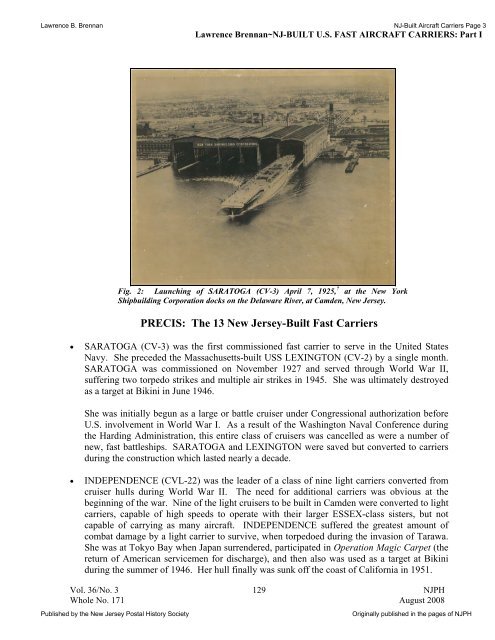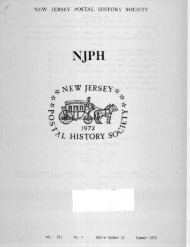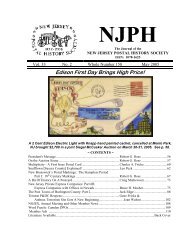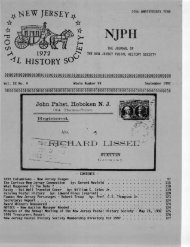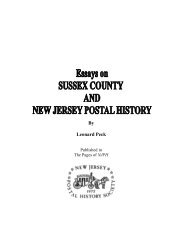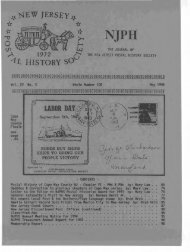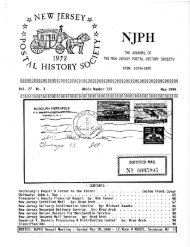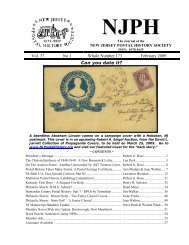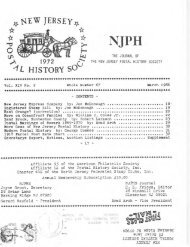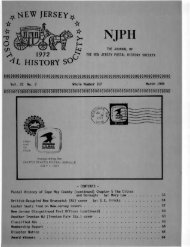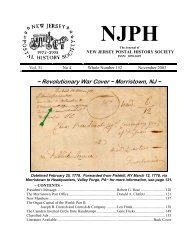By Captain Lawrence B. Brennan, U.S. Navy (Ret.) - New Jersey ...
By Captain Lawrence B. Brennan, U.S. Navy (Ret.) - New Jersey ...
By Captain Lawrence B. Brennan, U.S. Navy (Ret.) - New Jersey ...
Create successful ePaper yourself
Turn your PDF publications into a flip-book with our unique Google optimized e-Paper software.
<strong>Lawrence</strong> B. <strong>Brennan</strong> NJ-Built Aircraft Carriers Page 3<br />
<strong>Lawrence</strong> <strong>Brennan</strong>~NJ-BUILT U.S. FAST AIRCRAFT CARRIERS: Part I<br />
Fig. 2: Launching of SARATOGA (CV-3) April 7, 1925, 7 at the <strong>New</strong> York<br />
Shipbuilding Corporation docks on the Delaware River, at Camden, <strong>New</strong> <strong>Jersey</strong>.<br />
PRECIS: The 13 <strong>New</strong> <strong>Jersey</strong>-Built Fast Carriers<br />
• SARATOGA (CV-3) was the first commissioned fast carrier to serve in the United States<br />
<strong>Navy</strong>. She preceded the Massachusetts-built USS LEXINGTON (CV-2) by a single month.<br />
SARATOGA was commissioned on November 1927 and served through World War II,<br />
suffering two torpedo strikes and multiple air strikes in 1945. She was ultimately destroyed<br />
as a target at Bikini in June 1946.<br />
She was initially begun as a large or battle cruiser under Congressional authorization before<br />
U.S. involvement in World War I. As a result of the Washington Naval Conference during<br />
the Harding Administration, this entire class of cruisers was cancelled as were a number of<br />
new, fast battleships. SARATOGA and LEXINGTON were saved but converted to carriers<br />
during the construction which lasted nearly a decade.<br />
• INDEPENDENCE (CVL-22) was the leader of a class of nine light carriers converted from<br />
cruiser hulls during World War II. The need for additional carriers was obvious at the<br />
beginning of the war. Nine of the light cruisers to be built in Camden were converted to light<br />
carriers, capable of high speeds to operate with their larger ESSEX-class sisters, but not<br />
capable of carrying as many aircraft. INDEPENDENCE suffered the greatest amount of<br />
combat damage by a light carrier to survive, when torpedoed during the invasion of Tarawa.<br />
She was at Tokyo Bay when Japan surrendered, participated in Operation Magic Carpet (the<br />
return of American servicemen for discharge), and then also was used as a target at Bikini<br />
during the summer of 1946. Her hull finally was sunk off the coast of California in 1951.<br />
Vol. 36/No. 3<br />
129<br />
NJPH<br />
Whole No. 171 August 2008<br />
Published by the <strong>New</strong> <strong>Jersey</strong> Postal History Society<br />
Originally published in the pages of NJPH


